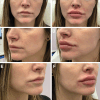Achieving Bratz Doll Look with Lip Fillers: A Prospective Observational Study on Blunt Cannula Techniques
- PMID: 38623443
- PMCID: PMC11018163
- DOI: 10.1097/GOX.0000000000005731
Achieving Bratz Doll Look with Lip Fillers: A Prospective Observational Study on Blunt Cannula Techniques
Abstract
Background: This study aims to evaluate the efficacy and safety of a blunt cannula technique using hyaluronic acid fillers for achieving the Bratz doll lip aesthetic, characterized by enhanced volume and sharp definition.
Methods: Thirty volunteers, 22-40 years of age, were selected based on specific inclusion criteria at Albany Cosmetic and Laser Center for 6 months. The technique involved precise filler injections using a Steriglide blunt cannula. Pre- and postprocedure measurements of lip dimensions and angular changes were meticulously documented and analyzed using IBM SPSS Statistics software.
Results: The procedure significantly increased the average height of both the upper and lower vermilion zones, with notable changes in angular measurements and the distance between the midline and oral commissure, aligning with the Bratz doll aesthetic. Importantly, none of the participants experienced bruising, a common side effect in traditional needle-based methods. The overall satisfaction rate was high, with an average score of 8.5 out of 10, reflecting the procedure's success in meeting aesthetic goals and ensuring participant comfort.
Conclusions: The blunt cannula technique for lip augmentation presents a safe and effective alternative to traditional needle-based methods. The absence of bruising and high satisfaction rates underscore the technique's precision and alignment with patient safety and comfort. This study contributes to the field of cosmetic lip enhancement, offering a novel approach that balances aesthetic aspirations with health considerations, potentially influencing future practices in cosmetic procedures.
Copyright © 2024 The Authors. Published by Wolters Kluwer Health, Inc. on behalf of The American Society of Plastic Surgeons.
Conflict of interest statement
The authors have no financial interest to declare in relation to the content of this article.
Figures





References
-
- Hernandez J. The art and politics of Black and Latina embodiment. In Hernandez J. (ed.), Aesthetics of Excess. Durham, NC: Duke University Press; 2020:63–72.
-
- Harris S. Minimally invasive lip treatments: from alienisation to normalisation. J Aesthet Nurs. 2023;12:S18–S20.
-
- Vitosyte M, Malinauskaite D, Chalas R, et al. . Lip morphometry and morphologic pattern variation by ethnicity. Anthropol Anz. 2023;80:13–21. - PubMed
-
- #bratzlips on TikTok. Tiktok.com. Available at https://www.tiktok.com/tag/bratzlips. Published 2024. Accessed on January 18, 2024.
-
- #bratzdolllips on TikTok. Tiktok.com. Available at https://www.tiktok.com/tag/bratzdolllips. Published 2024. Accessed on January 18, 2024.
LinkOut - more resources
Full Text Sources
